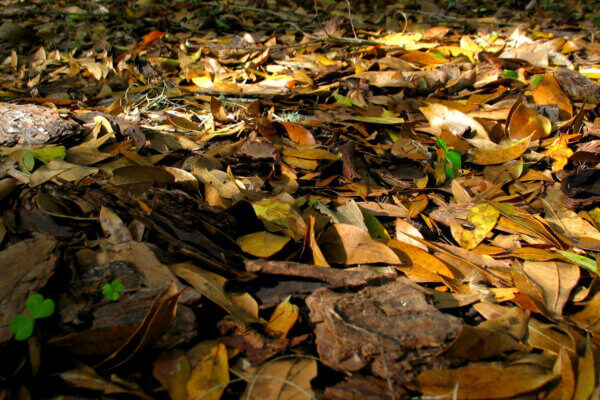I love my garden and I love working in it. Unfortunately, it’s a seasonal thing. Once winter approaches I do all I can to protect and preserve my garden for the next spring.
Many people, myself included, cover their gardens with mulch. Others purchase mulch chips for their garden.
Personally, I let the leaves fall and, instead of using a hefty leaf blower like my neighbor in suburbia used, I rake my leaves onto the garden to protect it for the winter.
https://www.instagram.com/p/BPadMeAjtcS/?tagged=leafmulch
It might seem strange to use what is already there to protect the gardens, but that’s what our ancestors did. Why shouldn’t we as well?
I just don’t see the point of paying good money to purchase large quantities of mulch and/or peat moss when I have the makings of a good mulch to fertilize and protect my gardens right on my very own property. And while it means a little more work, it’s worth it.
Creating Natural Mulch
The process starts in the autumn when I rake up the leaves to cover the gardens. Then, in winter, I scoop up the leaf carpet that’s been compacted over the months from the heavy snow. Finally, in the spring, I make sure to uncover the new growth before it grows too much. This all being said, the benefits far outshine the hardship.

There are so many benefits to natural mulch. The nutrients that bleed into the soil nourish the next season’s new growth. The carpet of leaves protects the garden from all kinds of potentially damaging elements, like road salt.
Road Salt: A Garden Nightmare
When I lived in suburbia, my thick leaf carpet, when it was rolled away in the spring, was covered in a layer of road salt. I would carefully roll the leaf carpet around the salt collection and dispose of the contents. My garden had been saved from a killing spree that this heavy layer of road salt would have initiated.
However, the story was not the same for my suburban neighbors. Their bare front yard, thoroughly cleared of leaves the previous fall, was dead. The road salt had killed nearly everything in its path, even the weeds.
The neighbors—who had scowled at my leaf mulch—would then have to dig up their front yard and re-plant. They did this every year, for the nineteen years that we lived next to them. They probably still do.
In the country, I continue to protect my gardens with natural leaf mulch. I have lots of trees on my one-acre lot, so there’s a healthy supply of leaves each fall.
https://www.instagram.com/p/BUgR2IoFqTa/?tagged=leafmulch
My gardens near the road are protected from the road salt, while the gardens elsewhere on the property are insulated from the brutal erratic climatic changes that happen more and more each year. Snow, freezing rain, thawing, and then more snow and freezing rain. I like to think that my plants are thanking me each spring when I uncover the gardens.
Saving The Trees
In the spring, the leaf carpet benefits the trees, especially in drought years where water is scarce at best. We’ve had a couple of summers in a row with severe drought conditions.
Being on a well, I can’t risk my own water supply to water the trees, so I depend on the leaf carpet to help maintain some of the moisture around the tree roots. Eventually, the leaf carpet decomposes into a rich soil that will continually benefit the trees and surrounding growth.
Leaf Mulching For The Lawn
Leaf mulching the lawn is also a good idea, though you shouldn’t leave too thick of a layer of leaves on the lawn. This may smother the grass. Divide the leaf mulch between lawn and garden, or rake the leaves into isolated corners of the property to allow them to decompose or create a mold.
https://www.instagram.com/p/BUWH7mnjacF/?tagged=leafmulch
Leaves are full of minerals that their trees soaked up from the soil. Earthworms and microorganisms work to break down the leaf mulch, turning it into organic matter.
By mulching the leaves, particularly my sugar maple leaves, the soil underneath both the garden and the lawn benefit from extra organic matter they otherwise wouldn’t get. This leaf mulching process also helps lighten heavier soils and makes sandy soils retain more moisture.
Adding Mulching Leaves To Compost
Autumn leaves should also be added to the compost. As a rich source of carbon, the leaves will help balance the nitrogen in the compost.
There are some leaves that serve this purpose better than others. Sugar maple leaves are one of the best, while others like walnut, eucalyptus, and camphor laurel contain plant growth inhibitors. These leaves should be composted first before adding them to the garden soil.
Nature has a way of regenerating and promoting healthy growth. It’s all there for us to use. And the benefits are multiple. Never mind the neighbor that wants to blow his leaves away—and yours as well. Mulch your leaves and your garden and lawn will thank you.
Today’s post is brought to you by award-winning author and artist, Emily-Jane Hills Orford. When this author isn’t writing, creating collage paintings, working on her needlework or composing, you’ll find her in the garden. Even in the winter, gardening is not far from her thoughts as she plans and prepares for the next season and the next growing adventure.










































Leave a Reply